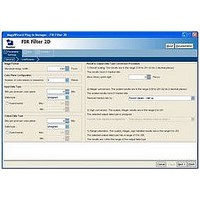IPS-VIDEO Altera, IPS-VIDEO Datasheet - Page 13

IPS-VIDEO
Manufacturer Part Number
IPS-VIDEO
Description
MegaCore Suite W/ 17 DSP Video/image Processing Functions
Manufacturer
Altera
Type
-r
Specifications of IPS-VIDEO
Software Application
IP CORE, SUITES
Supported Families
Arria GX, Cyclone II, HardCopy II, Stratix II
Core Architecture
FPGA
Core Sub-architecture
Arria, Cyclone, Stratix
Rohs Compliant
NA
Function
Suite of IP Functions for Video and Image Processing
License
Initial License
Lead Free Status / RoHS Status
na
Lead Free Status / RoHS Status
na
- Current page: 13 of 214
- Download datasheet (6Mb)
Chapter 1: About This MegaCore Function Suite
General Description
May 2011 Altera Corporation
Color Plane Sequencer
Color Space Converter (CSC)
Control Synchronizer
Deinterlacer
Deinterlacer II
The Color Plane Sequencer MegaCore function changes how color plane samples are
transmitted across the Avalon-ST interface.
You can configure the channel order in sequence or in parallel. In addition to
reordering color plane samples, the Color Plane Sequencer splits and joins video
streams, giving control over the routing of color plane samples.
The Color Space Converter MegaCore function transforms video data between color
spaces. These color spaces allow you to specify colors using three coordinate values.
The Color Space Converter supports a number of predefined conversions between
standard color spaces, and allows the entry of custom coefficients to translate between
any two three-valued color spaces. You can configure the Color Space Converter to
change conversion values at run time using an Avalon-MM slave interface.
You can use the Control Synchronizer MegaCore function to synchronize the
configuration change of MegaCores with an event in a video stream. For example, this
MegaCore function could synchronize the changing of a position of a video layer with
the changing of the size of the layer.
The Deinterlacer MegaCore function converts interlaced video to progressive video
using a bob, weave, or simple motion-adaptive algorithm. Interlaced video is
commonly used in television standards such as phase alternation line (PAL) and
national television system committee (NTSC), but progressive video is required by
LCD displays and is often more useful for subsequent image processing functions.
Additionally, the Deinterlacer can provide double -buffering or triple-buffering in
external RAM. Double-buffering can help solve throughput problems (burstiness) in
video systems. Triple-buffering can provide simple frame rate conversion.
The Deinterlacer II MegaCore function provides you the option of using high quality
motion-adaptive deinterlacing algorithms that significantly enhances edge-adaptive
reconstruction and improves image quality streams. The Deinterlacer II does not
support lower quality bob and weave deinterlacing.
The buffering behavior is significantly different than the Deinterlacer, and the
Deinterlacer II does not support triple buffering. All deinterlacing algorithms in the
Deinterlacer II require external RAM.
The Deinterlacer II provides you the option to detect a 3:2 cadence in the input video
sequence and perform a reverse telecine operation for perfect restoration of the
original progressive video.
Video and Image Processing Suite User Guide
1–5
Related parts for IPS-VIDEO
Image
Part Number
Description
Manufacturer
Datasheet
Request
R

Part Number:
Description:
CYCLONE II STARTER KIT EP2C20N
Manufacturer:
Altera
Datasheet:

Part Number:
Description:
CPLD, EP610 Family, ECMOS Process, 300 Gates, 16 Macro Cells, 16 Reg., 16 User I/Os, 5V Supply, 35 Speed Grade, 24DIP
Manufacturer:
Altera Corporation
Datasheet:

Part Number:
Description:
CPLD, EP610 Family, ECMOS Process, 300 Gates, 16 Macro Cells, 16 Reg., 16 User I/Os, 5V Supply, 15 Speed Grade, 24DIP
Manufacturer:
Altera Corporation
Datasheet:

Part Number:
Description:
Manufacturer:
Altera Corporation
Datasheet:

Part Number:
Description:
CPLD, EP610 Family, ECMOS Process, 300 Gates, 16 Macro Cells, 16 Reg., 16 User I/Os, 5V Supply, 30 Speed Grade, 24DIP
Manufacturer:
Altera Corporation
Datasheet:

Part Number:
Description:
High-performance, low-power erasable programmable logic devices with 8 macrocells, 10ns
Manufacturer:
Altera Corporation
Datasheet:

Part Number:
Description:
High-performance, low-power erasable programmable logic devices with 8 macrocells, 7ns
Manufacturer:
Altera Corporation
Datasheet:

Part Number:
Description:
Classic EPLD
Manufacturer:
Altera Corporation
Datasheet:

Part Number:
Description:
High-performance, low-power erasable programmable logic devices with 8 macrocells, 10ns
Manufacturer:
Altera Corporation
Datasheet:

Part Number:
Description:
Manufacturer:
Altera Corporation
Datasheet:











